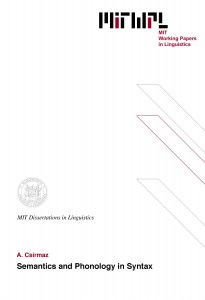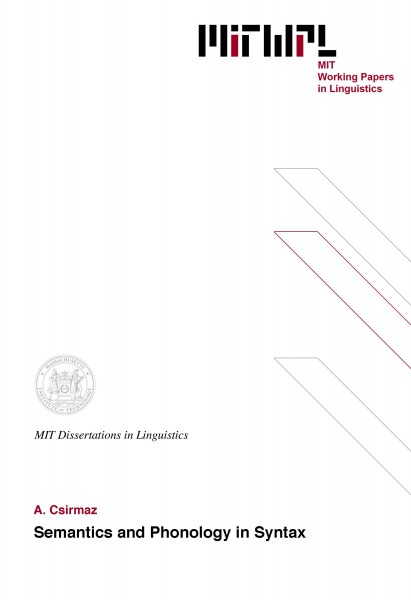Semantics and Phonology in Syntax
A. Csirmaz, 2005
In this thesis I argue that morphology should be allowed to interpret not only the information provided by the syntactic component, but also compositional semantic properties. This conception of grammar requires morphology to interact with LF and the semantic component in addition to syntax. Applying this hypothesis, I account for the alternation between partitive and non-partitive structural case in Finnish, which is affected by the semantic property of divisibility. I argue that the property of divisibility, which is relevant for case alternation, is determined within Spell-out domains, which are interpreted immediately following Spell-out. Building on these domains as affecting case marking, I derive the differences between divisibility as determined in the final semantic interpretation. I also discuss the properties of negated event predicates in detail, and argue for a specific view of the semantic import of negation on aspect. I show that in spite of the apparent semantic similarities, the effects of negation on Finnish case marking cannot be assimilated to the instances of case alternation determined by divisibility. I extend this conclusion and discuss the nature of divisibility licensed by negation crosslinguistically in more detail. Finally, I consider further areas where the interaction between semantics and morphology or the phonological form can be detected. I argue that while some of these interactions can be treated by assuming that the latter components are sensitive to semantic properties, not all interactions can be described this way. In general, however, permitting the interaction between semantics and morphology or phonology is desirable and leads to a more economical system, where the number of non-convergent derivations is maintained.
Thesis Supervisor: Sabine Iatridou
Title: Professor of Linguistics
<br/>
Table of Contents
Chapter 1 Introduction 13
1.1 The Minimalist Program 14
1.2 Late insertion 17
1.3 Multiple Spell-out 22
1.4 Phases 27
1.4.1 All vPs are phases 28
1.4.2 Phasehood diagnostics and DP phases 30
1.5 Multiple Agree 34
Chapter 2 Morphological Case Patterns in Finnish 39
2.1 R-expressions 40
2.1.1 Abstract case 41
2.1.2 Accusative as a dependent case 43
2.2 Pronouns 49
Chapter 3 Partitive case alternation in Finnish 55
3.1 Partitive case licensed by properties of the nominal interpretation 56
3.1.1 Divisibility and case marking 57
3.1.2 The interaction of divisibility and case marking 65
3.2 Partitive case licensed by properties of the event predicate 69
3.2.1 Divisibility and case marking 74
3.2.1.1 Delimiters 75
3.2.1.2 Iterative and habitual interpretation 80
3.2.1.3 An ambiguity in divisibility and case marking 82
3.2.2 The range of partitive constituents 87
3.3 Adjunct positions 90
3.4 Case as a [divisible] feature 98
3.4.1 A precedent: case as [uT] 99
3.4.2 Arguments against case as [divisible] 103
3.4.2.1 [Divisible] and LF interpretation 104
3.4.2.2 Arbitrariness in [divisible] assignment 106
3.4.2.3 The object-adjunct assymetry 108
3.4.2.4 Structural and inherent case 109
3.4.2.5 [Divisible] and subevent ordering 110
3.5 Summary 111
Chapter 4 Negated event predicates and partitive case 113
4.1 Partitive case and negation 114
4.2 Negation in Finnish 119
4.3 Similarities across languages 126
4.3.1 Russian genitive of negation 126
4.3.2 Polish genitive of negation 127
4.3.3 Finnish partitive of negation 130
4.4 Summary 131
Chapter 5 Negated event predicates and divisibility 133
5.1 Background assumptions 134
5.1.1 Time intervals 134
5.1.2 Modification of time intervals 137
5.2 For-adverbs and negated event predicates 142
5.3 Quantifiers and divisibility 147
5.3.1 Downward entailing quantifiers 147
5.3.2 Arguments modified by only 149
5.3.3 Other approaches 152
5.3.3.1 A DRT approach 152
5.3.3.2 Nominal event predicate properties 153
5.3.3.3 Cumulative interpretation 159
5.4 Negation and stativity 162
5.4.1 Arguments for non-stativity 163
5.4.1.1 Present tense interpretation 163
5.4.1.2 Discourse structure 164
5.4.2 Agentivity 166
5.4.2.1 Imperatives 166
5.4.2.2 Complement of force and persuade 168
5.4.2.3 Complement of must 170
5.4.2.4 Agentive of adverbs 171
5.5 A syntactic restriction on temporal adverbs 174
5.5.1 Adverbs restricted to event time modification 175
5.5.2 The source of the restriction 178
5.5.2.1 Locality of case licensing 179
5.5.2.2 Locality of adverb modification 180
5.6 Summary 182
Chapter 6 Alternative accounts 183
6.1 Partitive is inherent case 183
6.2 Accusative objects and completed events 184
6.3 Weak case 185
6.4 Partitive case with imperfective events 188
6.5 Unbounded predicates, maximal events and partitive objects 193
6.6 Degrees and case 196
6.6.1 The interpretation of degree adverbs 198
6.6.2 No necessary correlation between degree adverbs and case 199
6.7 An optimality-theoretic account 203
6.8 Accusative case as telicity 206
6.8.1 Telicity as culmination 206
6.8.2 Nominal-related partitive case and null determiners 209
6.9 Summary 211
Chapter 7 Conclusion and extensions 213
7.1 Summary 213
7.2 Extensions 214
7.2.1 Focus 215
7.2.1.1 Against a focus feature 216
7.2.1.2 Prosody in syntax 218
7.2.1.3 Focus and interface interaction 220
7.2.2 Polarity items 222
7.2.2.1 Restrictions on surface structure 224
7.2.2.2 Semantic constraints 226
7.2.2.3 A uniform treatment of PPIs , NPIs and negative
quantifiers 230
References 235

